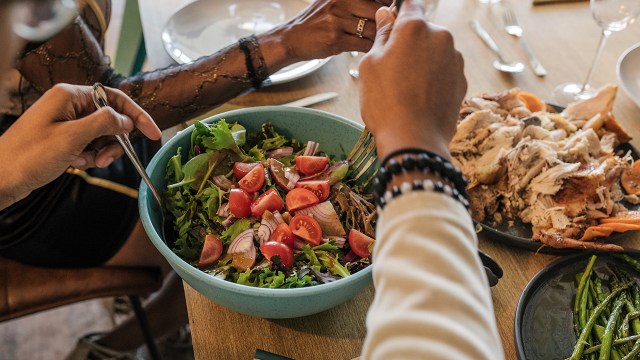
As food prices have crept up, eating healthy has gotten tougher for many Americans. An overwhelming majority (90%) of adults say healthy food has gotten more expensive in recent years.
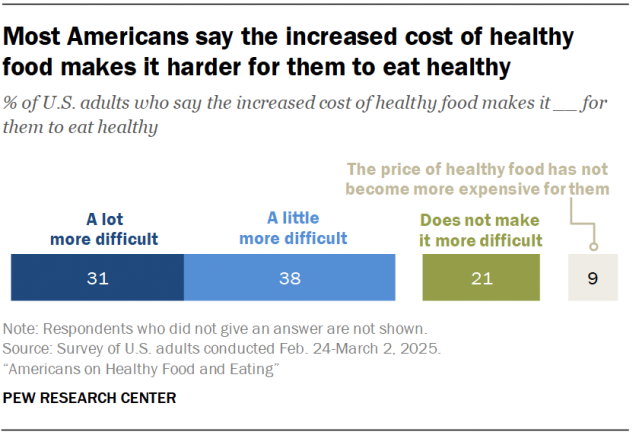
And 69% say these price hikes make it more difficult for them to eat healthy. These are among the findings from a Pew Research Center survey conducted from Feb. 24 to March 2, 2025, among 5,123 U.S. adults.
Beyond supermarket sticker shock, Americans’ mealtime choices also are playing out against the backdrop of several other dynamics: rising obesity levels, proliferation of food delivery options, and a wave of diet trends and recommendations on social media. We conducted this survey to understand U.S. adults’ priorities and behaviors around healthy food and eating. This study builds on our previous work looking at Americans’ attitudes about and experiences with emerging health issues.
Key highlights
- About two-in-ten Americans describe their own diets as extremely or very healthy, with a far larger share saying their diets are somewhat healthy (59%). One-fifth say their diets are not too or not at all healthy.
- When deciding what to eat, how the food tastes is a high priority for a large majority (83%) of Americans. About half say the same of food healthiness.
- Eating home-cooked meals is far more common than ordering takeout or delivery or eating at restaurants. Nearly nine-in-ten eat home-cooked meals at least a few times a week, compared with 17% ordering takeout or delivery and 12% eating at restaurants that frequently.
- Americans who eat a home-cooked meal every day are more likely to describe their diets as extremely or very healthy, compared with those who have home cooking less frequently (29% vs. 12%).
- Roughly seven-in-ten Americans say the increased cost of healthy food in recent years has made it more difficult to eat healthy. A larger share of lower-income adults than upper-income express this view (77% vs. 54%).
Jump to: How Americans rate their own diets | What’s important to Americans when making food choices? | Where Americans get their food | Healthy food cost, access and knowledge
How Americans rate their own diets
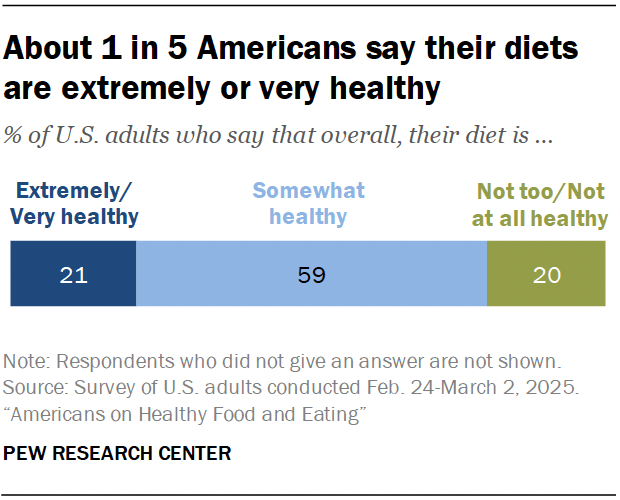
Poor diets are a driver of major public health challenges in the United States, like obesity and heart disease. And nutrition experts say that many U.S. adults have unhealthy diets.
When asked how healthy their own diets are, U.S. adults largely give middling reviews. About six-in-ten say that, overall, their diet is somewhat healthy. A much smaller share say their diets are extremely or very healthy (21%). And one-in-five say their diets are not too or not at all healthy.
Older, upper-income and highly educated adults are more likely to say they have healthy diets than younger, lower-income and less educated Americans.
Notably, Republicans and Democrats offer similar views of the healthiness of their own diets, as well as the factors that shape their food choices more broadly. Food and diet have been emphasized in the current presidential administration, with Health and Human Services Secretary Robert F. Kennedy Jr. prioritizing tackling obesity and working to ban certain food dyes.
Findings by additional demographic characteristics are presented in the appendix.
What’s important to Americans when making food choices?
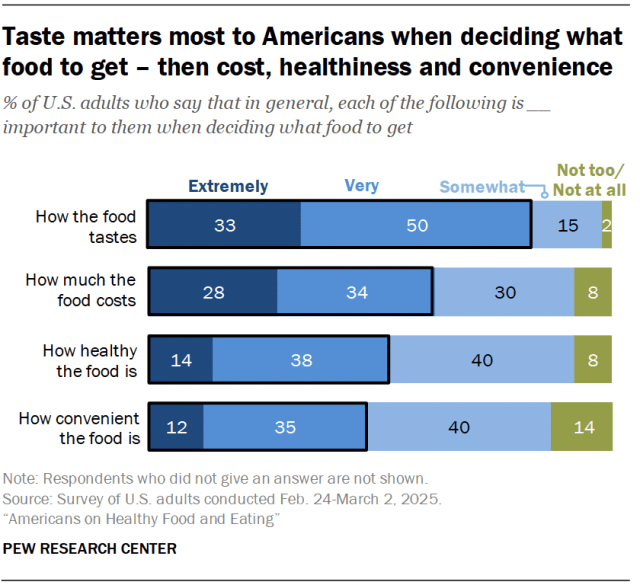
Busy schedules, tight budgets, taste preferences and health concerns all can play a role in eating decisions. This survey asked U.S. adults about how important each of four considerations are when deciding what food to get: taste, cost, healthiness and convenience.
Taste of food
Solid majorities of U.S. adults say all four aspects are at least somewhat important. But how the food tastes tops the list by a sizable margin when it comes to what Americans feel is extremely or very important. A strong majority (83%) says taste is this important.
Large majorities of Americans across gender, race and ethnicity, age, and income say taste is extremely or very important in deciding what to eat. Across all these subgroups, at least seven-in-ten strongly prioritize taste.
Price consciousness
Sticker price can affect eating choices, and cost ranked second as a priority among the four criteria we asked about. Cost is highly important to roughly six-in-ten Americans when it comes to choosing what food to get, and it plays a bigger role among lower-income respondents than those who are upper income. Three-quarters of lower-income Americans say cost of food is extremely or very important when deciding what food to get, 36 percentage points higher than among upper-income adults.
Healthiness of food
About half (52%) say the healthiness of food is highly important when deciding what to eat. And prioritizing healthiness in food tracks with reporting a healthier diet. Among Americans who say healthiness in food is extremely or very important, 35% describe their own diets as highly healthy, compared with 3% of adults who say healthiness is not too or not at all important.
Larger shares of Black (58%) and Hispanic adults (57%) than of White adults (49%) say healthiness of food is extremely or very important.
By 11 points, women highly value healthiness of food more than men (58% of women vs. 47% of men). And more women than men feel all four priorities we asked about are highly important: taste (86% of women vs. 79% of men), cost (66% of women vs. 57% of men) and convenience (50% of women vs. 43% of men).
Convenience of getting and preparing food
Of the four criteria we asked about, the smallest share (47%) strongly prioritize how convenient the food is to get and prepare. How much value Americans place on convenient eating varies by age, with younger adults prioritizing convenience more than older.
Where Americans get their food
Mealtime decisions are about what to eat as well as where to get food. Home cooking typically is considered healthier and cheaper than eating out or ordering in. At the same time, the growth of food delivery apps and online take out ordering can make it easier and faster to eat restaurant-made meals.
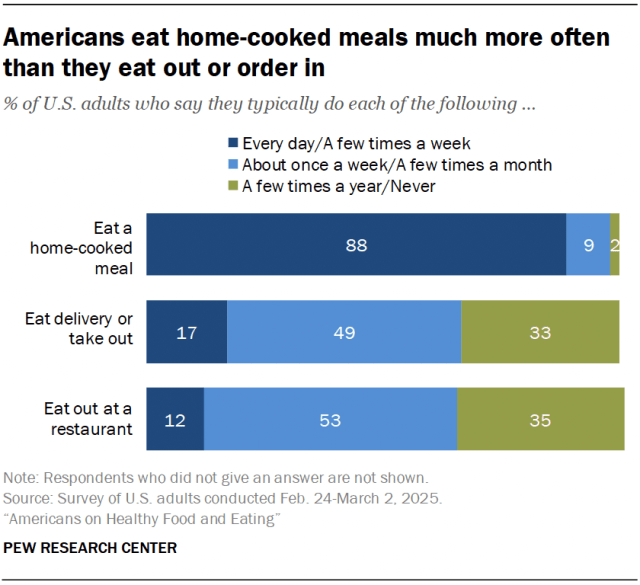
Eating home-cooked meals is far more common than eating out or ordering in. Nearly nine-in-ten adults eat a home-cooked meal at least a few times a week. Much smaller shares (17%) say they eat delivery or takeout at this clip, and 12% say the same of eating at a restaurant.
Eating out and ordering in are infrequent occurrences for some. One-third say they order takeout or delivery a few times a year or never, and 35% say the same of eating at a restaurant.
Where Americans get food is related to how healthy they say their diets are
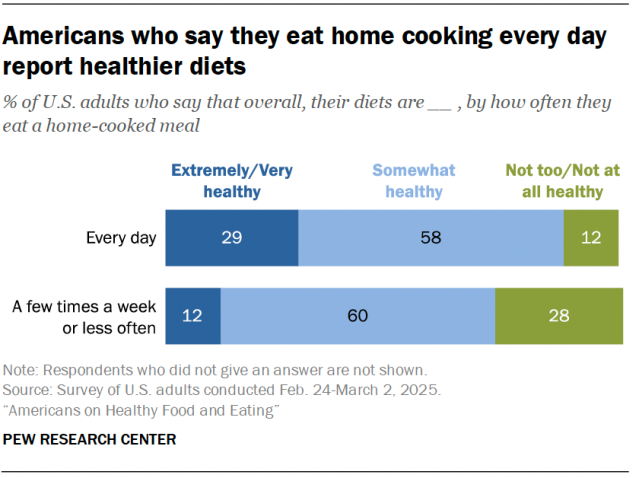
Our survey finds that the more Americans say they eat home-cooked meals, the healthier they say their diets are. About three-in-ten Americans who eat home cooking every day say their diets are extremely or very healthy. This drops to 12% among adults who have home-cooked meals less frequently.
Conversely, 28% of Americans who eat home cooking a few times a week or less describe their diets as not too or not at all healthy, compared with 12% of those who have home cooking daily.
In contrast, Americans who order takeout or delivery most frequently report less healthy diets than those who order in less often. About one-third of adults who order in at least a few times a week say their diets are not too or not at all healthy. That percentage drops to 18% for Americans ordering in about once a week or a few times a month, and to 15% for those who rarely or never do.
Ordering takeout or delivery is more common among those who prioritize convenience
Among adults who say convenience is extremely or very important to their food choices, 23% order delivery or takeout at least a few times a week. That’s about twice the share that order in this often among Americans who say convenience is not too or not at all important.
Dining out and ordering in is less common among lower-income Americans
Americans at the lower end of the income scale don’t eat out or order in as much as higher-income adults. About half of lower-income Americans eat out at a restaurant a few times a year or never. In contrast, 18% of upper-income adults say the same.
The income gap is less pronounced for ordering takeout or delivery. The share of lower-income adults (38%) who say they rarely or never order in is 10 points higher than among upper-income Americans (28%).
Healthy food cost, access and knowledge
In addition to looking at individual preferences when it comes to food choices, we asked about three influences on Americans’ ability to get healthy food: cost, access and knowledge.
Price pressures
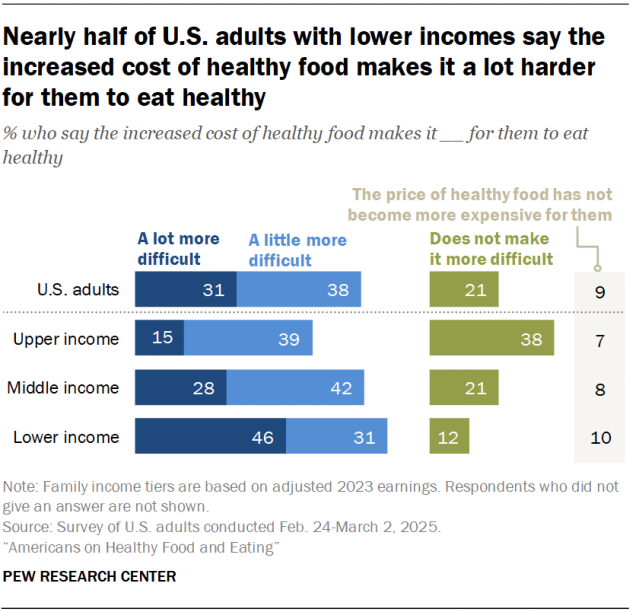
Food prices have crept up in recent years – and are expected to keep rising in 2025. Americans resoundingly agree: 90% say that over the last few years, the price of healthy food has become a lot or a little more expensive.
But does this affect Americans’ ability to eat healthy?
- A majority of Americans (69%) say yes, the increased cost of healthy food makes it a lot or a little more difficult for them to eat healthy. About two-in-ten say it does not make it harder for them to eat healthy, while 9% say the price of healthy food has not become more expensive for them.
- Lower-income adults are much more likely than upper-income adults to say it’s become harder for them to eat healthy. This gap is especially stark when it comes to Americans who say it’s a lot more difficult to eat healthy. Nearly half of lower-income Americans (46%) say the increased cost makes it a lot more difficult to eat healthy, compared with 15% of upper-income adults – a 31-point gap.
Access to healthy food
Having a healthy diet can be especially challenging for Americans who struggle to find healthy food where they live. People in racial and ethnic minority groups, those with lower incomes and those living in rural areas are more likely to lack access to healthier foods.
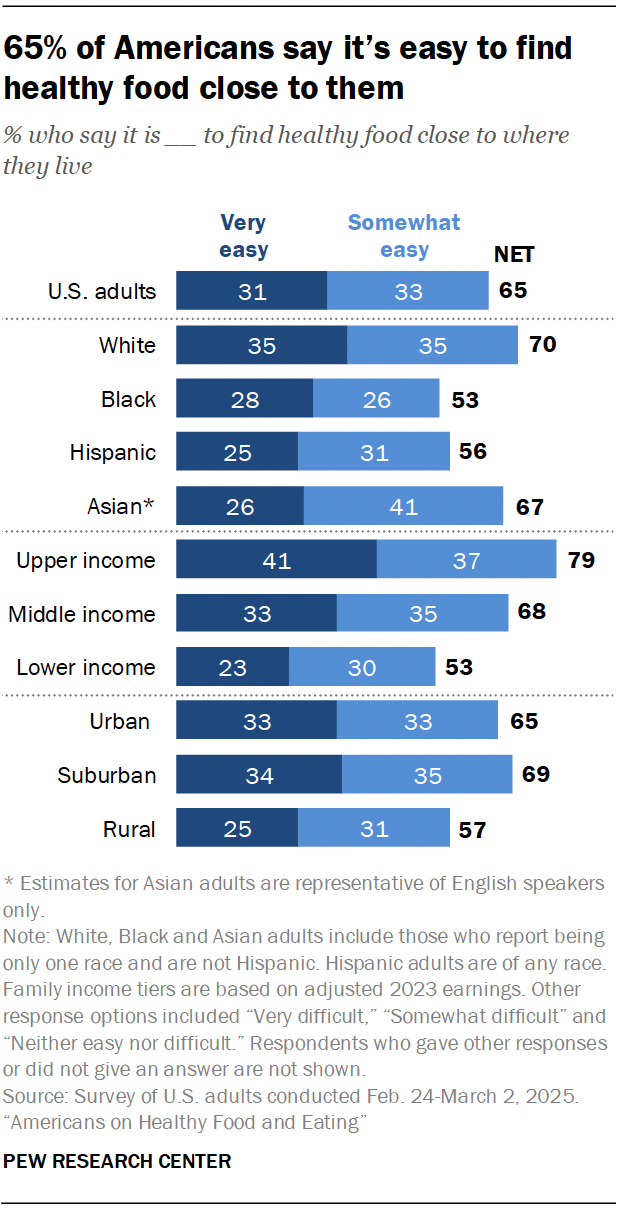
On balance, Americans say it is easy to find healthy food close to where they live. About two-thirds (65%) say it is very or somewhat easy to find healthy food close to them. In contrast, 13% say it is very or somewhat difficult to find healthy food close to them. And 21% say it is neither easy nor difficult.
- More White and Asian adults than Black or Hispanic adults say it’s easy to find healthy food nearby. Solid majorities of White (70%) and Asian adults (67%) say it’s easy to find healthy food close to where they live. Comparatively smaller shares of Black (53%) and Hispanic adults (56%) say the same.
- Upper-income adults have greater access to healthy food than those with lower incomes. Adults with higher incomes are much more likely than lower-income adults to say it’s easy to find healthy food close to them (79% vs. 53%).
- Larger shares of urban and suburban Americans say they can easily find healthy food nearby, compared with rural Americans. About two-thirds of those who live in urban (65%) and suburban areas (69%) say it’s easy to find healthy food close to them. A smaller majority of rural adults say the same (57%).
Healthy food knowledge
Eating decisions also can be shaped by knowledge about which foods are healthy. But making sense of nutrition guidance and recommendations isn’t always easy.
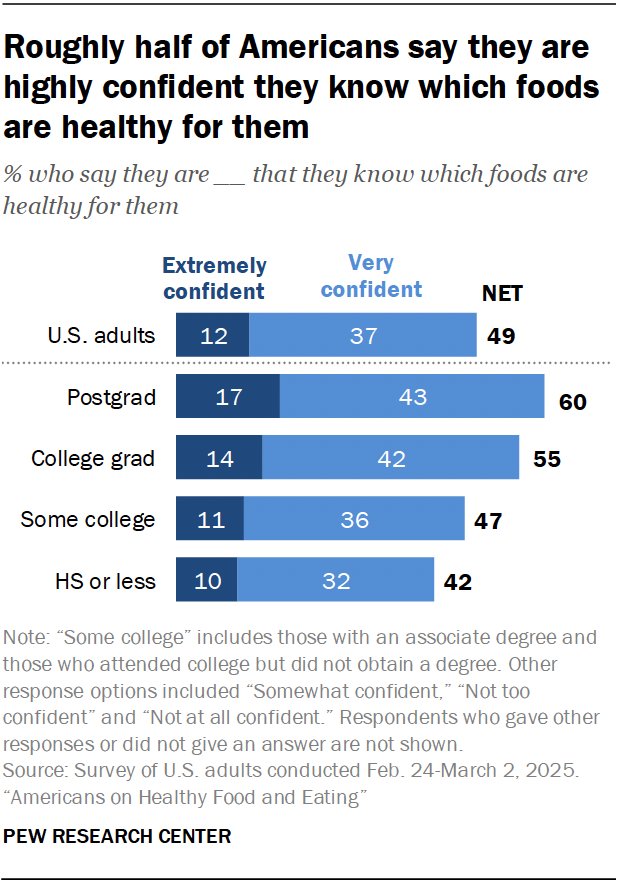
- About half of Americans (49%) say they are extremely or very confident that they know which foods are healthy for them. About four-in-ten say they are somewhat confident; another 9% say they are not too or not at all confident.
- Americans with higher levels of education express more confidence in their knowledge of healthy food than those with less formal education. For example, those with a postgraduate degree are 18 percentage points more likely than those with a high school education or less to say they are highly confident they know which foods are healthy for them (60% vs. 42%).
Americans who are more confident in their knowledge of healthy food are more likely to say their diet is healthy. A third of those who express high confidence in their healthy food knowledge say their diet is extremely or very healthy, compared with just 5% of those who express little to no confidence in their healthy food knowledge.
On the flip side, 53% of Americans who have little to no confidence in their healthy food knowledge say their diet is not too or not at all healthy. Just 11% of adults with high confidence in their healthy food knowledge say the same about their diet.




